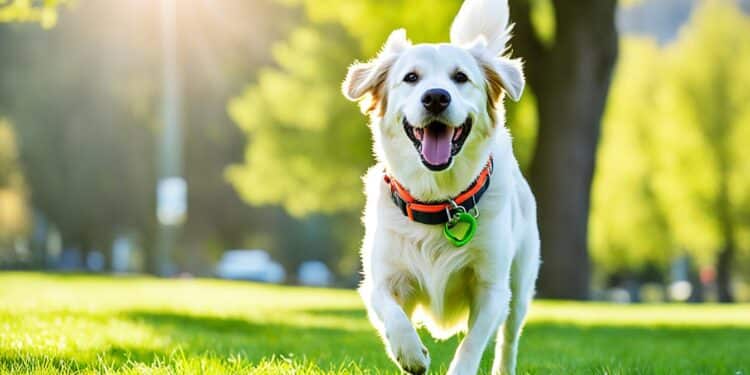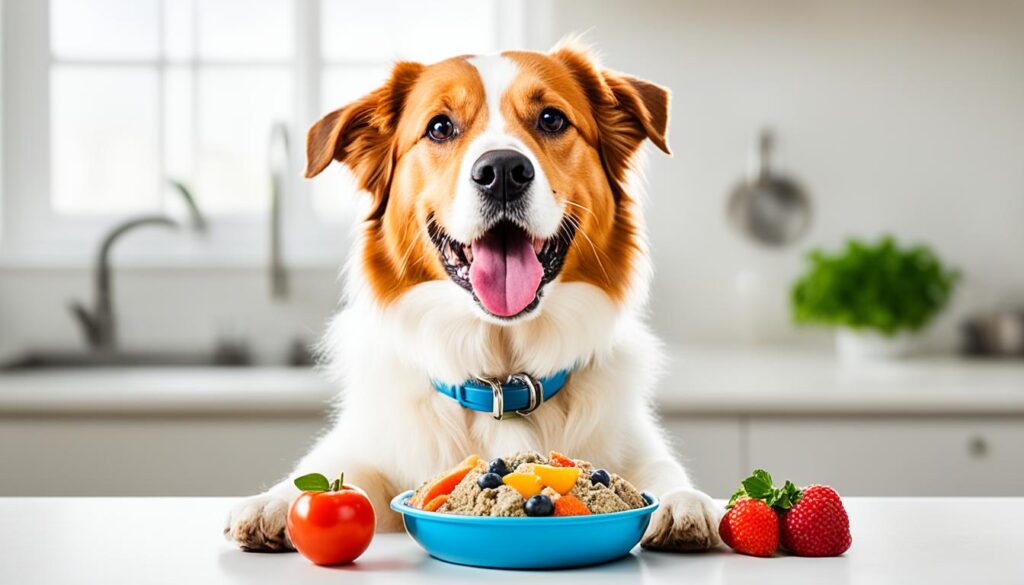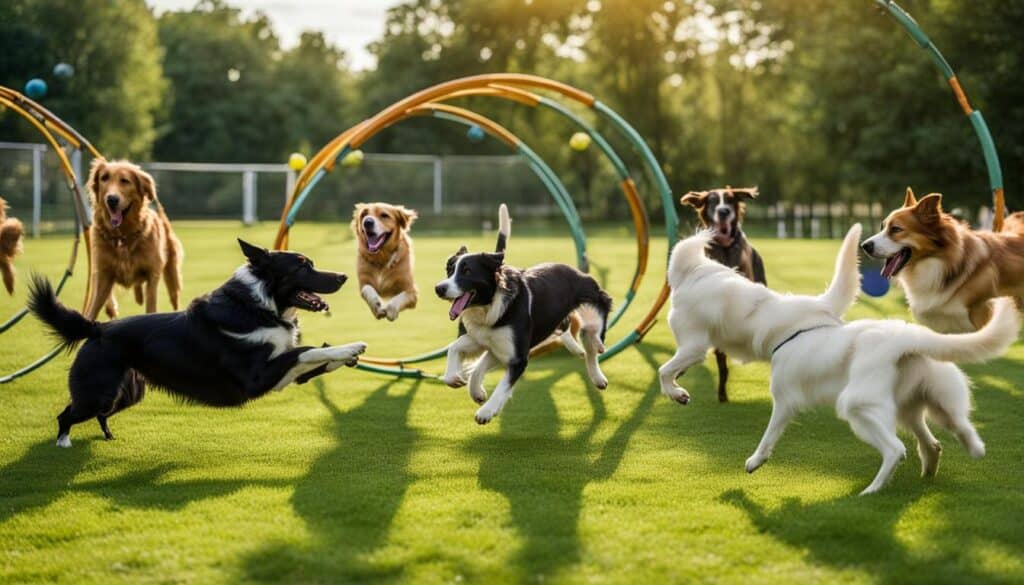Dog Lifestyle: Tips for Happy, Healthy Pets

When it comes to dog health and wellness, their lifestyle plays a crucial role. As a responsible dog owner, I understand the importance of providing my furry friend with the best care possible. From nutrition to exercise, grooming to training, there are essential tips and practices that can ensure our dogs thrive and lead happy, healthy lives.
Creating a balanced and fulfilling lifestyle for our canine companions is key. By addressing their physical, mental, and emotional needs, we can promote their overall well-being. Here are some valuable dog care tips that have helped me optimize my dog’s lifestyle and enhance our bond.
Dog Training and Behavior: Building a Strong Bond
Training and socializing your dog are crucial aspects of their lifestyle. Proper training not only teaches them essential skills but also helps establish boundaries and build a strong bond between you and your pet. Additionally, socialization plays a vital role in ensuring that your dog is comfortable around other animals and people.
When it comes to dog training, consistency and positive reinforcement are key. By using rewards such as treats and praise, you can motivate your dog to learn and follow commands. Start with basic commands like sit, stay, and come, gradually progressing to more advanced skills. Remember to be patient and understanding, as every dog learns at their own pace.
“Training a dog is a mutual learning experience. I find that using positive reinforcement, such as treats and praise, works wonders in motivating my furry friend.”
Behavior Tips:
- Set clear rules and boundaries to establish a structure that your dog can understand.
- Consistently enforce positive behaviors and discourage negative ones.
- Provide mental stimulation through puzzle toys and interactive games to keep your dog engaged and prevent behavioral issues.
- Seek professional help if your dog exhibits severe behavioral problems, such as aggression or anxiety.
Tips for Socialization:
- Expose your dog to various environments, sights, sounds, and other animals from an early age.
- Organize playdates with well-behaved dogs to encourage positive interactions and improve social skills.
- Gradually introduce your dog to new people, ensuring that the encounters are positive and rewarding.
- Enroll in obedience classes or hire a professional trainer to facilitate socialization in a controlled environment.
To strengthen the bond with your dog, it’s important to spend quality time together. Go for walks, engage in play sessions, and provide plenty of love and affection. Remember, building a strong bond requires patience, consistency, and a lot of positive reinforcement!
Dog Nutrition: Feeding a Balanced Diet
Providing your dog with a balanced diet is crucial for their overall health and well-being. It’s important to feed them high-quality dog food that meets their specific nutritional needs. A balanced diet ensures that your dog receives all the necessary nutrients, vitamins, and minerals to support their growth, maintain their immune system, and prevent certain health issues.
When choosing dog food, it’s essential to read the labels carefully and opt for brands that prioritize high-quality ingredients. Look for dog food that contains real meat as the primary protein source, as well as a good balance of carbohydrates and healthy fats. Avoid foods that use artificial preservatives, fillers, and by-products.
Your dog’s nutritional requirements may vary depending on their age, breed, size, and activity level. Puppies, adult dogs, and senior dogs have different dietary needs, so it’s important to consult with your veterinarian to determine the best feeding guidelines for your furry friend.
“A balanced diet ensures that your dog receives all the necessary nutrients, vitamins, and minerals to support their growth, maintain their immune system, and prevent certain health issues.”
Specific Nutritional Requirements
Different dog breeds may have specific nutritional requirements based on their breed’s characteristics and predisposition to certain health conditions. For example:
| Breed | Specific Nutritional Requirements |
|---|---|
| Labrador Retriever | High-quality protein for muscle development, joint support, and energy |
| Chihuahua | Small kibble size and adequate calorie intake to prevent obesity |
| Bulldog | Digestible and easily chewable food to prevent gastrointestinal issues |
| German Shepherd | Dietary supplements for hip and joint health |
It’s crucial to be aware of any breed-specific nutritional requirements and tailor your dog’s diet accordingly. Regularly monitoring your dog’s weight and overall health will help you determine if adjustments need to be made to their feeding plan.
Dog Exercise Routines: Keeping Them Active
Regular exercise is crucial for maintaining your dog’s physical and mental health. Just like humans, dogs need physical activity to stay in shape and mental stimulation to keep their minds sharp. Incorporating a consistent exercise routine into your dog’s lifestyle is essential for their overall well-being.
Different types of activities can provide your dog with the exercise they need. Here are some recommended exercises:
- Walking: Taking your dog for daily walks is a great way to keep them active and help them burn off excess energy. It’s also an excellent opportunity for bonding and exploring new environments.
- Running or jogging: If you’re an active person, consider taking your dog for a run or jog. This high-intensity exercise can help build their cardiovascular endurance and keep them physically fit.
- Playing fetch: Playing fetch is not only a fun game for dogs but also a fantastic way to provide them with both physical and mental exercise. It engages their natural instinct to chase and retrieve, keeping them entertained and active.
- Swimming: Swimming is a low-impact exercise that is gentle on your dog’s joints, making it ideal for older dogs or those with certain health conditions. It provides a whole-body workout and helps keep them cool in hot weather.
Regular exercise offers numerous benefits to your dog’s overall health:
- Weight management: Keeping your dog at a healthy weight is essential for preventing obesity-related health issues. Regular exercise can help burn calories and maintain a healthy body weight.
- Muscle tone and strength: Physical activity helps strengthen your dog’s muscles, improving their overall fitness and mobility.
- Joint health: Exercise helps keep your dog’s joints flexible and reduces the risk of conditions such as arthritis.
- Behavioral benefits: A tired dog is a well-behaved dog. Regular exercise can help reduce behavioral problems such as excessive barking, chewing, and digging.
- Increased mental stimulation: Engaging in activities that challenge your dog’s mind, such as learning new tricks or participating in puzzle games, can help keep them mentally sharp and prevent boredom.
To ensure that your dog gets enough exercise, it’s important to establish a routine that suits their age, breed, and overall health. Start slowly and gradually increase the duration and intensity of the activities. Remember to always prioritize safety and consult your veterinarian if you have any concerns or questions.
Exercise not only benefits your dog physically but also contributes to their overall happiness and well-being. A tired and content dog is more likely to be relaxed, better behaved, and enjoy a higher quality of life. So, lace up your shoes, grab your dog’s leash, and embark on an exciting exercise routine together!
| Activity | Description |
|---|---|
| Walking | Taking your dog outdoors for a leisurely stroll. It helps to strengthen their muscles and provides mental stimulation. |
| Running or jogging | Engaging in a higher-intensity workout with your dog. It offers cardiovascular benefits and is especially beneficial for energetic breeds. |
| Playing fetch | Throwing a ball or toy for your dog to retrieve. It combines physical exercise and mental stimulation, as they chase and bring back the object. |
| Swimming | Allowing your dog to swim in a safe environment. It is a low-impact exercise that is gentle on the joints and provides a full-body workout. |
Dog Grooming Tips: Keeping Them Clean and Healthy
Grooming plays a vital role in maintaining the cleanliness and overall health of your dog. Regular grooming not only keeps your furry friend looking their best but also helps prevent various health issues. Here are some essential dog grooming tips to ensure your pet stays clean and healthy:
1. Brush their coat regularly
Regular brushing not only helps in removing loose fur and preventing matting but also stimulates the skin and distributes natural oils, keeping your dog’s coat healthy and shiny. Use a brush suitable for your dog’s breed and coat type.
2. Trim their nails
Long nails can be uncomfortable for your dog and may cause difficulties in walking. Trim their nails regularly, being cautious not to trim too close to the quick as it may cause bleeding. If you’re unsure, seek guidance from a professional groomer or veterinarian.
3. Clean their ears
Your dog’s ears can be prone to ear infections and wax buildup. Gently clean their ears using a veterinarian-recommended ear cleaner and cotton balls. Avoid using cotton swabs as they can push debris deeper into the ear canal.
4. Brush their teeth
Just like humans, dogs can suffer from dental issues. Brushing their teeth regularly helps prevent tartar buildup, gum disease, and bad breath. Use a dog-friendly toothbrush and toothpaste to keep their teeth and gums healthy.
Remember, it’s important to introduce grooming routines gradually and make it a positive experience for your dog. Reward them with treats and praise to reinforce good behavior. If you’re unsure about any aspect of grooming or need assistance, consult with a professional groomer or veterinarian to ensure you’re providing the best care for your dog.
Dog-Friendly Activities: Fun and Bonding Time
Engaging in dog-friendly activities is not only enjoyable for your furry companion but also a great way to bond with them and provide mental stimulation. Dogs are social animals, and they thrive on interaction and physical exercise. Incorporating these activities into their lifestyle ensures a happy and healthy dog. Here are some dog-friendly activities that you can enjoy with your pet:
1. Going for Walks
Taking your dog for daily walks not only provides them with physical exercise but also offers an opportunity for exploration and mental stimulation. Choose different routes to keep things interesting and allow your dog to experience new smells and sights.
2. Playing Fetch
Playing fetch is a classic activity that dogs love. Find an open space, such as a backyard or a dog park, and use a ball or a frisbee to throw for your dog to retrieve. This game engages their natural chasing instincts and provides an outlet for their energy.
3. Visiting the Dog Park
Dog parks are an excellent way to socialize your furry friend and allow them to interact with other dogs. They can run freely, play with their canine companions, and make new friends. It’s important to ensure that your dog is well-behaved and up to date on their vaccinations before visiting a dog park.
4. Participating in Dog Sports
If your dog is active and enjoys a challenge, participating in dog sports can be a great option. Activities such as agility, flyball, or obedience training provide mental and physical stimulation for your pet while strengthening your bond through training and teamwork.
“Engaging in dog-friendly activities not only keeps your furry friend physically active but also helps prevent behavioral issues. These activities offer mental stimulation, which is crucial for a dog’s overall well-being.”
Remember to choose activities that are suitable for your dog’s age, breed, and energy level. It is always important to provide plenty of water, treats, and rest breaks during any physical activities. Listen to your dog’s cues and never force them to participate in activities they are not comfortable with.
5. Planning a Doggie Playdate
If your dog enjoys the company of other dogs, organizing a playdate with a friend or neighbor who has a dog can be a great way to provide social interaction and mental stimulation. Use a secure and controlled environment to ensure the safety of all dogs involved.
6. Teaching New Tricks
Teaching your dog new tricks is a mentally stimulating activity that strengthens the bond between you and your pet. Start with basic commands like sit, stay, or paw, and gradually progress to more advanced tricks. Use positive reinforcement and rewards to motivate your dog during the training process.
Remember to always prioritize your dog’s safety and well-being during any activity. If your dog has any health issues or specific limitations, consult with your veterinarian before engaging in strenuous activities. By incorporating these dog-friendly activities into your pet’s lifestyle, you’ll not only have a happier and healthier dog but also create memorable moments and a stronger bond with your furry friend.
Conclusion
By following these tips and incorporating them into your dog’s lifestyle, you can ensure that your furry friend is happy, healthy, and thriving. Taking care of their overall well-being involves not only training, nutrition, exercise, and grooming but also using the right dog accessories and products.
When it comes to dog accessories, investing in high-quality collars, leashes, and harnesses is essential for their safety and control during walks and outings. Look for durable materials and comfortable fits that will withstand regular use. Additionally, consider getting interactive toys that provide mental stimulation and promote active playtime.
Grooming supplies are also crucial for maintaining your dog’s cleanliness and health. A good brush and comb set will help keep their coat tangle-free and reduce shedding. Regularly cleaning their ears and brushing their teeth with appropriate dog-specific products will prevent infections and dental issues. Don’t forget to trim their nails to a safe length using professional nail clippers.
Remember, it’s always important to consult with your veterinarian for personalized advice and recommendations on dog accessories and products that suit your specific dog’s needs. With proper care, and the right accessories and products, your loyal companion can lead a life full of love, health, and happiness.
FAQ
Why is training and socializing my dog important?
Training and socializing your dog help establish boundaries, build a strong bond between you and your pet, and ensure they are comfortable around other animals and people.
What should I feed my dog for a balanced diet?
It’s important to feed your dog high-quality dog food that meets their specific nutritional needs. Consult with your veterinarian for personalized advice and recommendations.
How often should I exercise my dog?
It’s important to establish a consistent exercise routine that includes both physical and mental stimulation. The frequency and intensity of exercise depend on your dog’s breed, age, and health. Consult with your veterinarian for personalized recommendations.
How should I groom my dog?
Regular grooming includes brushing their coat, trimming their nails, cleaning their ears, and brushing their teeth. Consult with your veterinarian or a professional groomer for specific techniques and tips for your dog’s breed.
What are some dog-friendly activities I can do with my pet?
Dog-friendly activities can include going for walks, playing fetch, going to the dog park, or participating in dog sports. Find activities that your dog enjoys and incorporate them into your routine for bonding and mental stimulation.
What dog accessories and products should I use?
Collars, leashes, toys, and grooming supplies are essential dog accessories. Choose products that are appropriate for your dog’s size, breed, and specific needs. Consult with your veterinarian or a pet store professional for recommendations.
Are there any additional tips for taking care of my dog’s lifestyle?
Make sure your dog receives regular veterinary check-ups, maintains a healthy weight, and receives appropriate vaccinations and preventive care. Always consult with your veterinarian for personalized advice and recommendations for your specific dog.









